July 13th, 2015 One of my favorite group of objects that has come to Conservation Services for housing is the Zodiac Club peanut doll collection, housed in the Kansas Collection. As the name implies, it is a series of dolls made from shelled peanuts for heads, with wire bodies and intricate, period-appropriate dress.
The Zodiac Club was founded as women’s studying group, organized on February 5, 1878, by nine women from the Lawrence, KS area. Over the years the club met in members’ homes every Tuesday to read and discuss items relating to “cultural improvement.”
In 1943, when the Zodiac Club celebrated its 65th anniversary, twelve dolls were made to represent the original members of the Zodiac Club. The dolls are made of a frame of covered wire with peanuts for faces and dressed in costumes from the 1870s. Besides the dolls, the collection includes miniature period furniture, as well as leather-bound books, a tea service, spinning wheel, tintype photographs, needlepoint, and braid rug.
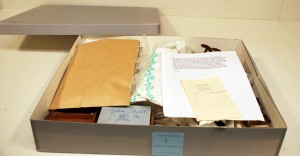
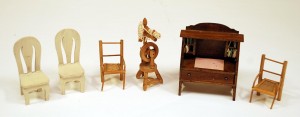
Left: Zodiac Club doll collection before housing. Right: Examples of the other items housed with the dolls.
Kansas Collection, call number RH MS Q61.
All the dolls, furniture, and other items were wrapped in paper towels and placed together in a box, making it difficult to tell what was in the box and to access particular items. A museum studies student intern was assigned to rehouse the collection into a more usable form.

Peanut-headed doll wrapped in paper towel. Note the fine detail in the costume.
Kansas Collection, call number RH MS Q61.
I asked her to create a housing that would keep the dolls and the other items in one box. She devised an ingenious two-tray system: the furniture and other items that are less frequently accessed are on the bottom layer, and the dolls are in a removable tray on top. Featured on the outside and inside of the box is a diagram that indicates how everything fits in the housing. Now the peanut ladies will be better protected and more easily displayed for many years to come.
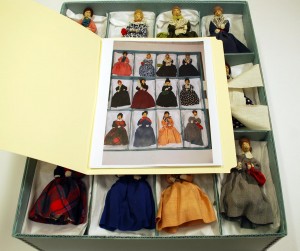
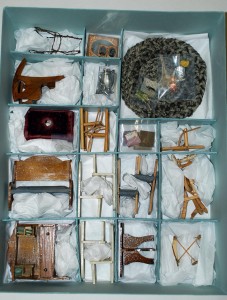
Left: Top tray with dolls and housing guide. Right: Bottom tray with furniture and other items.
Kansas Collection, call number RH MS Q61.
Whitney Baker
Head, Conservation Services
Tags: dollhouse furniture, KS, Lawrence, peanut doll, protective enclosures, Whitney Baker, women, Zodiac Club
Posted in Conservation, Kansas Collection |
No Comments Yet »
October 10th, 2012 Former conservation student assistant Haley Trezise reports on how she met the challenge of safely housing a group of metal Jayhawks.
I could hear the individual metal pieces sliding around inside before I even opened the box containing the metal Jayhawk paraphernalia. There was a small metal pendant set aside in an envelope; however, the rest of the items in the collection were awkwardly arranged at the bottom of a tall, slender box. Projects like this challenged me to find or make appropriate housing for Spencer items.
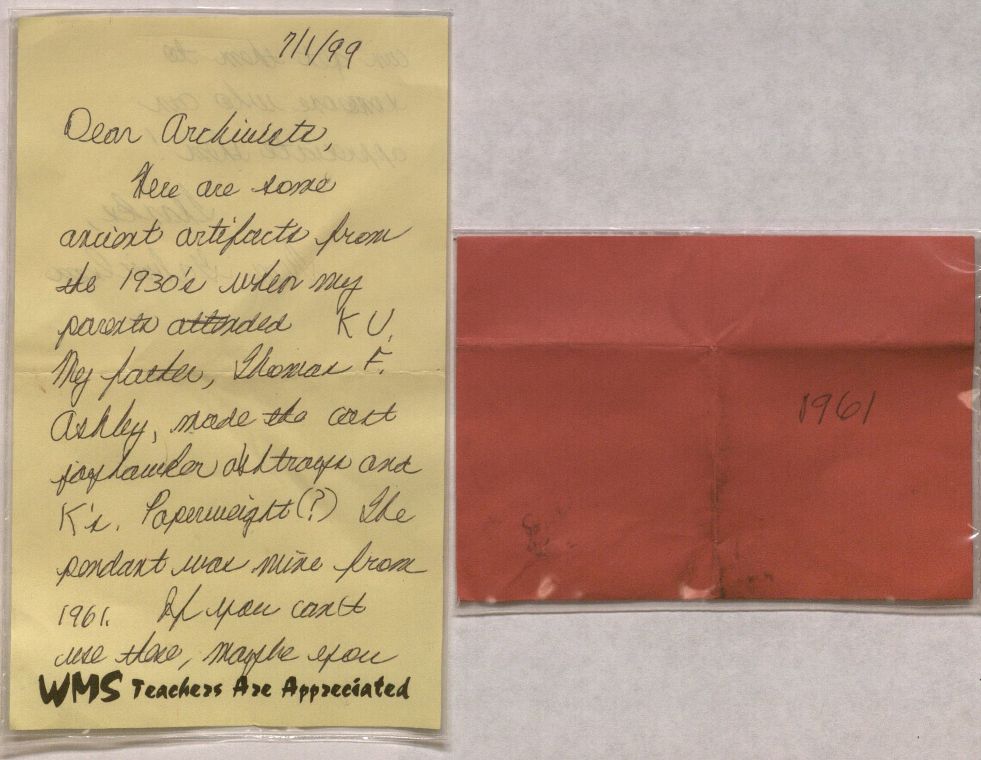
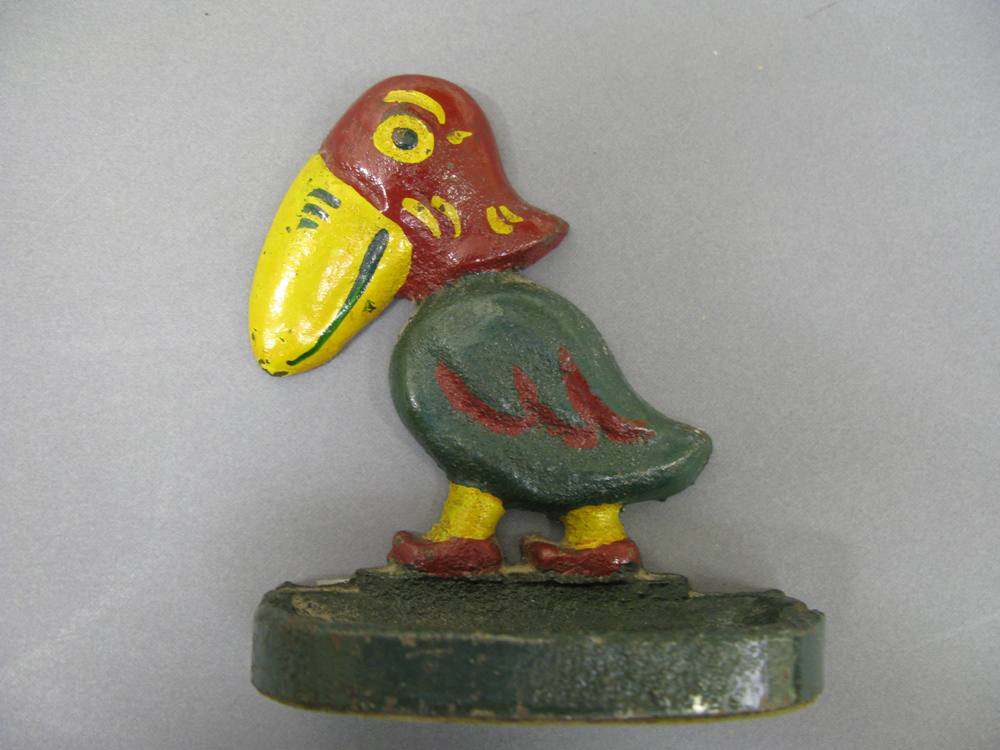
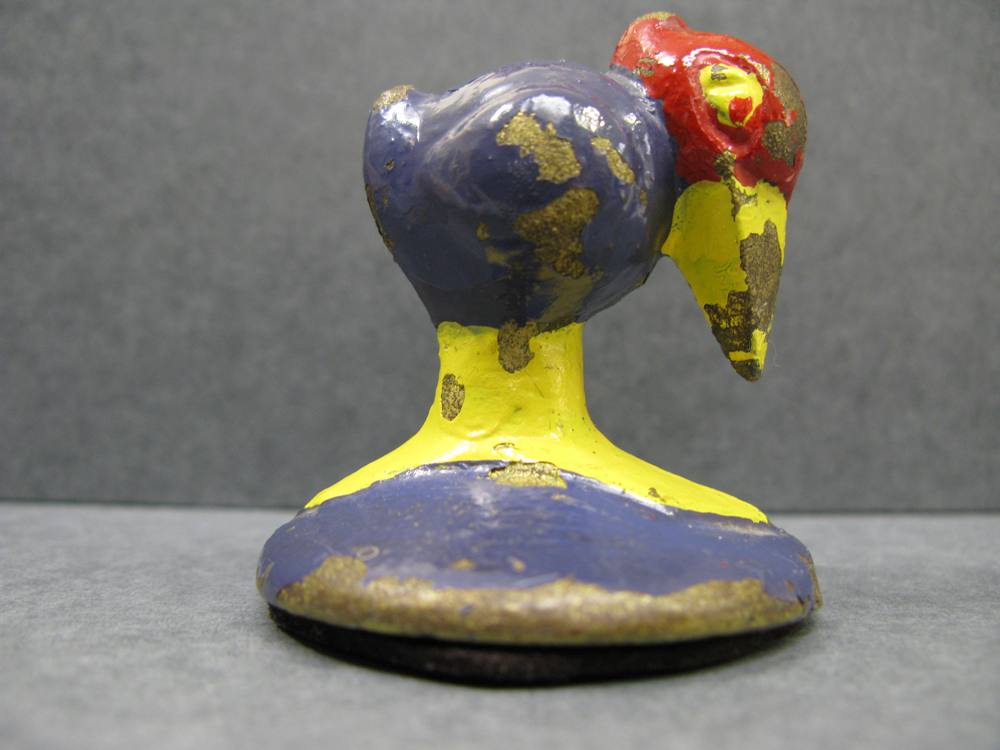
The challenge: A note to the archivist and two of several metal Jayhawk items all to be housed together.
Spencer Library Call Number: RG 0/25
I worked as a conservation student employee and Museum Studies intern during my last two semesters at KU. For one of my projects as an intern, I was asked to upgrade the housing for some metal Jayhawk paraphernalia. The parameters: all material should stay together in one box, including the accompanying written documents. I was provided a rather small, off-the-shelf box and told that all items should fit within that enclosure.

A new nest for metal Jayhawks. Spencer Library Call Number: RG 0/25
After considering various arrangements for best placement, I used plastazote foam, an inert (non-damaging) material that is easily shaped, to cut indentions for each object. I took a picture of the proper place for each item and placed it, along with the written information, in a sleeve inside the lid of the box. The image of what is stored in the box was also attached to the outside of the box so that the archivists can see what is inside without opening the lid.

Photos affixed to the exterior of the housing reveal at a glance the Jayhawk paraphernalia contained inside.
Spencer Library Call Number: RG 0/25. Click image to enlarge.
Haley Trezise
Former Conservation Student Assistant
Tags: conservation, Haley Trezise, Housing, Jayhawks, protective enclosures, University Archives
Posted in Conservation, University Archives |
No Comments Yet »
August 3rd, 2012 Summer Conservation Intern Cheyenne Bsaies reports on how to house huge, metal-clad volumes.
I want to talk to you about boxes. It’s a deceptively simple topic, truly. But the boxes I’m talking about are a far cry from the corrugated boxes every college student knows from moving apartments every summer. For one thing, the boxes I’ve been making are destined to house some of the rarer items in the Spencer collections. They’re studier than a corrugated box, they open differently and they’re cloth covered. In short, they’re very fancy boxes for very interesting and unusual tomes.
If you’ve never had the pleasure of seeing and/or handling a very old book, I highly recommend that you visit the Spencer Library and speak to a librarian there in order to avail yourself of their resources. Maybe the only old books you’ve seen have been in the movies when the protagonist uncovers a secret in an ancient library. They’re huge, leather beasts covered with metal studs and straps and clasps, and you just know something important is going to happen when the hero opens one of them.
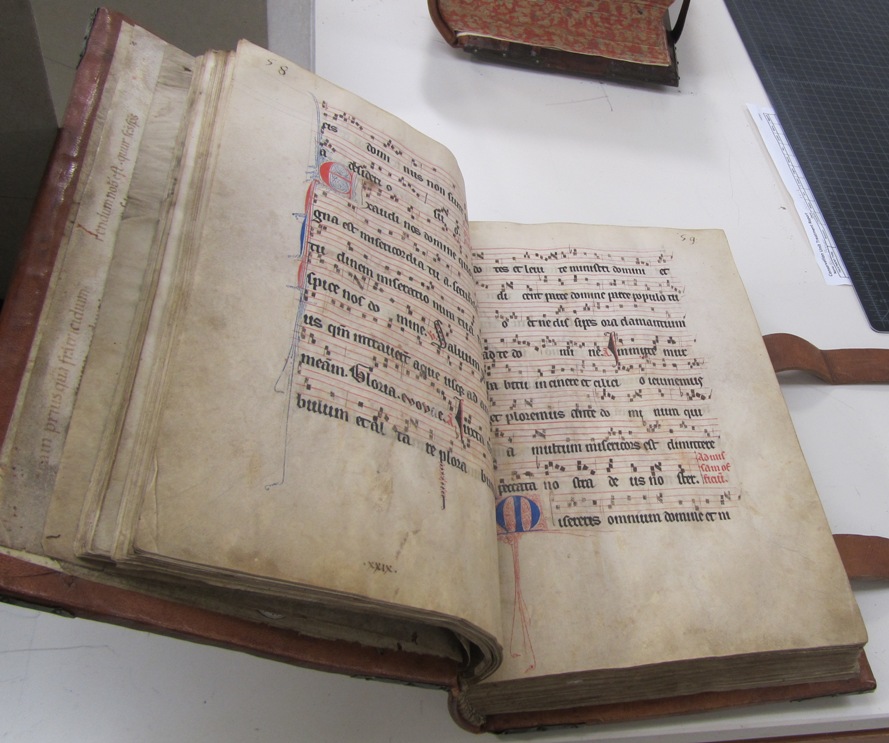
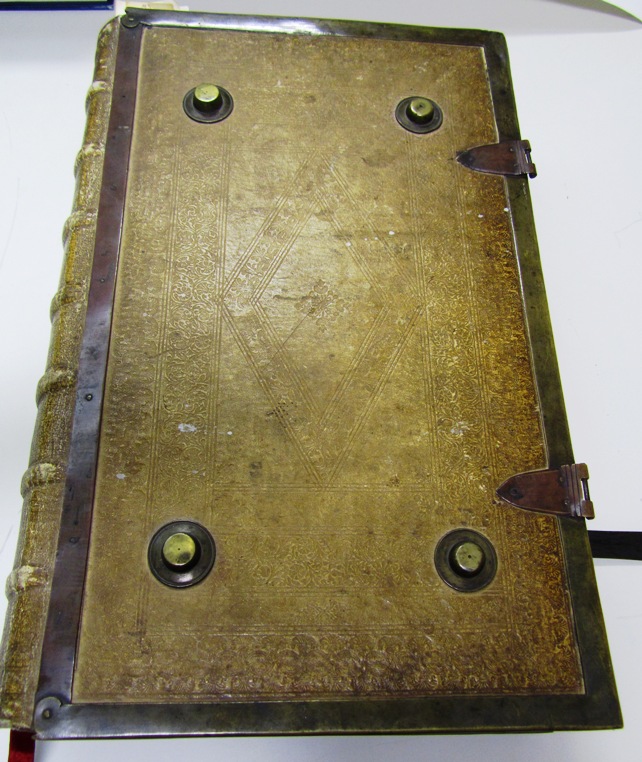
Left: Steinhardt Gradual. France, after 1253, (Call No.: MS J4:2); Right: Antiphonary,
Germany, 15–, (Call No.: MS J4:1). Click images to enlarge (trust us, they’re worth enlarging).
Well, those are exactly the books I had the pleasure of working with on this project! And, I have to admit, it’s hard not to feel a bit like Indiana Jones when turning their pages. First I’ll introduce each of them, talk about some of their special features, and then I’ll describe the box making process. Read the rest of this entry »
Tags: Altoviti Family Records, Antiphonaries, Cheyenne Bsaies, Clamshell boxes, conservation treatments, Graduals, Metal Bosses, protective enclosures
Posted in Conservation, Special Collections |
No Comments Yet »
June 13th, 2012 A clamshell or “drop spine” box is a typical housing for bound materials, like books and manuscripts, or loose materials that should be stored together, such as a set of prints. The fanciest clamshells are covered cloth, paper, or leather, and are custom-made to fit the item that will go inside.
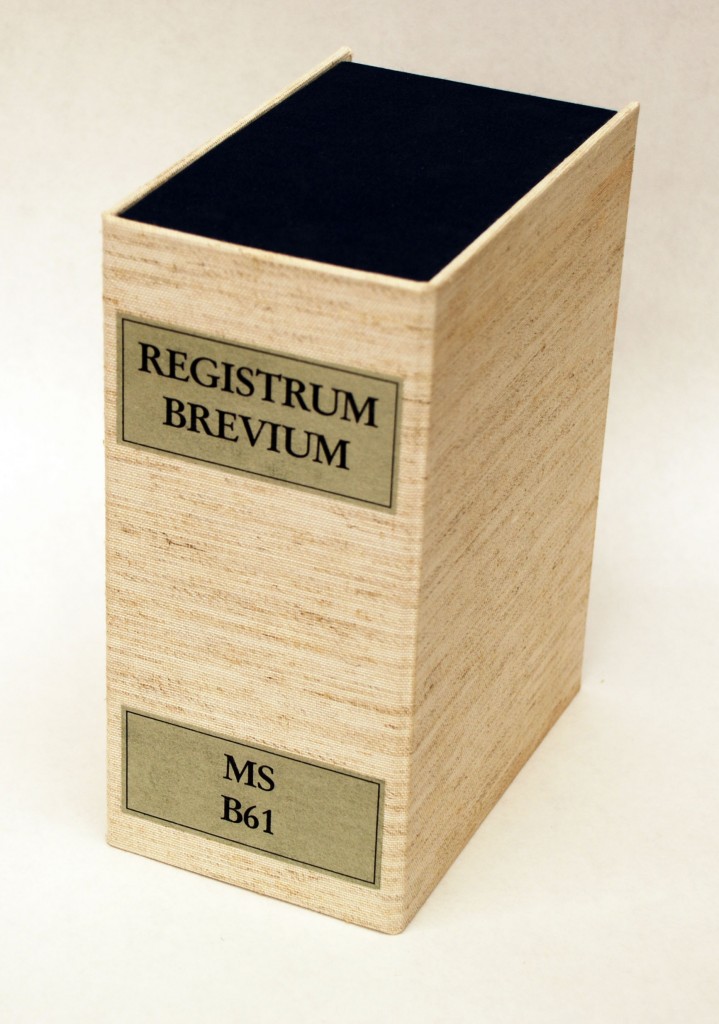
Here is an example made to fit MS B61, Registrum Brevium, a 14th century British manuscript written in Latin. This book, because of its age, had been bound in different styles over the centuries. The most recent iteration was a suede binding of the 19th or early 20th century, glued tightly to the backs of the folded pieces of parchment that were sewn together to make up the book. Read the rest of this entry »
Tags: Clamshell boxes, conservation, drop spine boxes, medieval manuscripts, protective enclosures, Registrum Brevium, Whitney Baker
Posted in Conservation, Special Collections |
No Comments Yet »
May 22nd, 2012 In Medieval Europe books were a precious commodity. Books were hand-copied manuscripts, and might be fashioned with metal hardware to chain them to a bookcase or desk to protect them from theft.
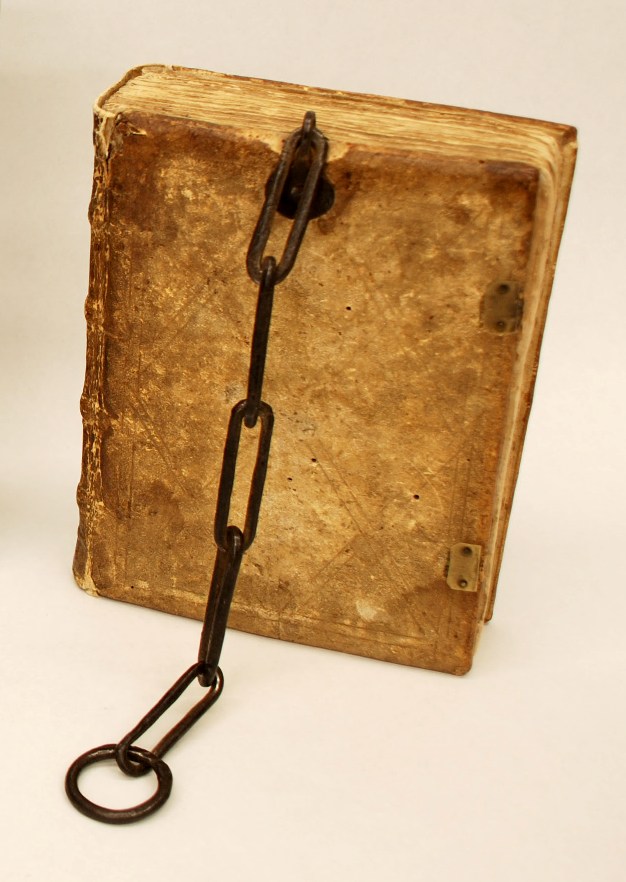
Sermones de sanctis by Frater Soccus. [Germany?] ca. 1370. Call Number: MS D84
This book is a bound manuscript likely from Germany, dated circa 1370. The text is Sermones de sanctis (call number: MS D84), writings of Frater Soccus, a monk from the Cistercian order. The pigskin binding, tooled all over the covers, has a chain attached to the back board at the top. Storing this on a modern shelf created problems, as the chain drapes down the back cover and makes it impossible to place another book next to it. Read the rest of this entry »
Tags: chained books, chained library, clamshell box, conservation treatments, Frater Soccus, medieval bindings, medieval manuscripts, protective enclosures, Sermones de sanctis, Whitney Baker
Posted in Conservation, Special Collections |
No Comments Yet »














